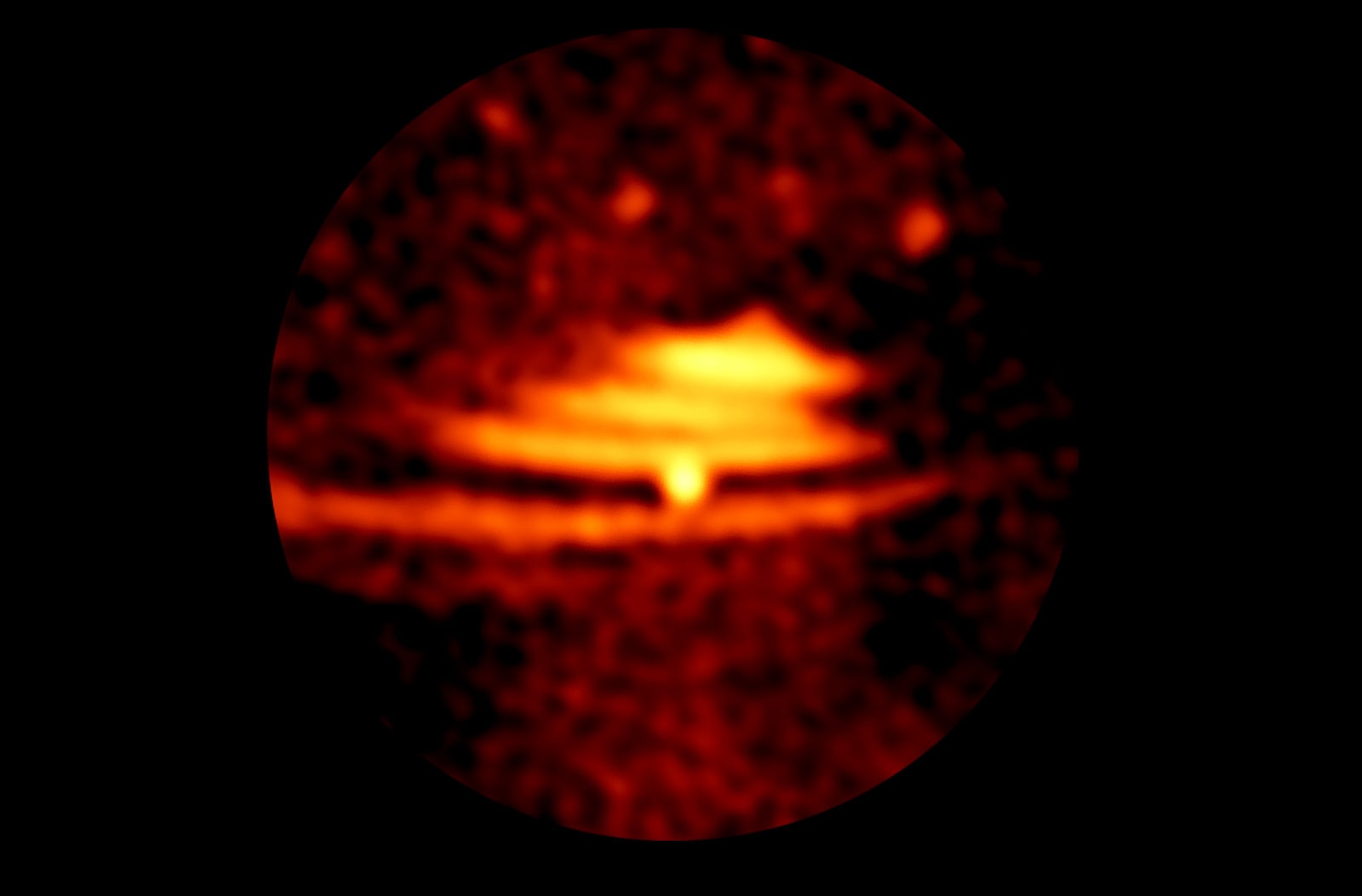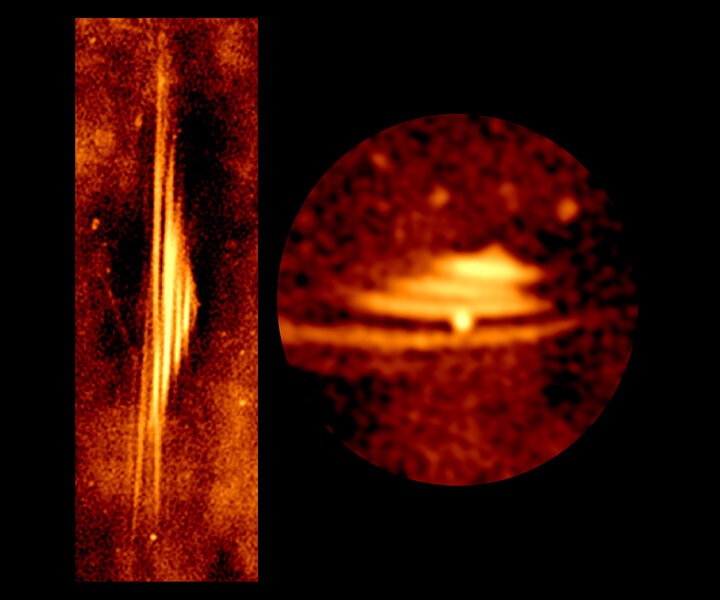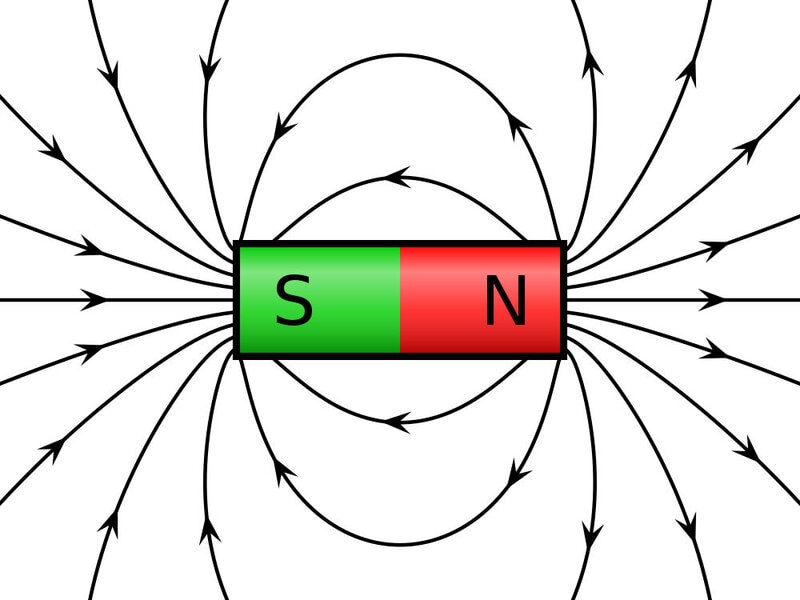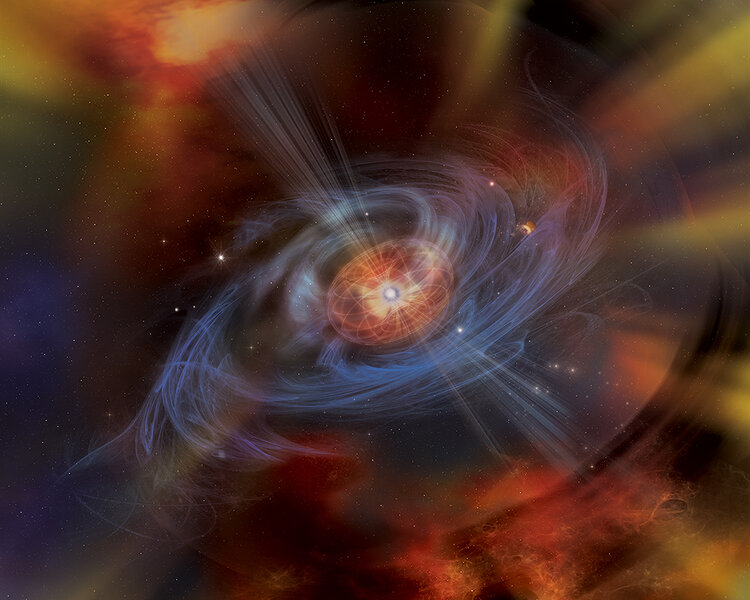Create a free profile to get unlimited access to exclusive videos, sweepstakes, and more!
A galactic Christmas tree lit up by magnetic fields and interloping stars

Look, I've been doing this astronomy thing for a long time. Like a long time. More often than not I can recognize a bright nebula or galaxy on sight, as well as a decent percentage of the battered and crater-scarred moons in the solar system. I've seen comets in outburst, storms erupt on the Sun, stars explode, and impacts on other planets.
It takes a lot to surprise me now. And it takes something really weird for me to sit up in my chair and say, "What the WHAT?!"
So when I saw these images, well.
What. The. WHAT.
Astronomers call these structures "harps," because they look like the strings on a harp: parallel and different lengths. The one on the right they call a "Christmas Tree," and I have to admit, yeah. Good call. Timely, too.
So what are they? Technically, they're time-dependent synchrotron radio emissions caused by cosmic rays streaming along magnetic field lines as a massive star or pulsar propagates through them, but I don't think that string of words helps much. But I can explain!
These two structures are located almost right along the line between the Sun and dead center in our galaxy. They're likely close to the galactic core, where there is a lot going on. Huge amounts of gas exists there between the stars, and activity in the region ionizes it — that is, the atoms have an electron or two (or more) stripped away from them. Gas like that we call a plasma. It acts in many ways like regular gas, but can be strongly affected by magnetic fields. And in fact this plasma has magnetic fields running through it in parallel lines, like the lines across an American football field*. The lines are several light years long, and are spaced some trillions of kilometers apart from each other.
Then an interloper barrels into the scene. Maybe it's a massive star shedding subatomic particles in a stellar wind (like the solar wind from the Sun), or maybe it's a pulsar, a kind of neutron star, the super-dense compact core of a star that previously exploded. Pulsars have fierce magnetic fields, so strong they can lift subatomic particles off the surface of the star (despite the surface gravity being millions or billions of times stronger than Earth's!) and send them shooting off into space.
Some of these subatomic particles have an electric charge; for example, electrons have a negative charge. That's important! A basic rule in physics is that a charged particle is affected by a magnetic field. It can change direction and move along those parallel lines in the interstellar gas. As it does a lot of very complicated things happen. As it moves it interacts with the magnetic field, causing the field to oscillate. This in turn interacts with the particle, causing it to move along the line even more in a sort-of feedback loop.
The magnetic field accelerates the particle, and another rule is that a charged particle emits light when it's accelerated. This is a pretty low-energy event, so the light it emits is low-energy, too: radio waves. Light created in this manner is called synchrotron emission, and that's what's being seen in these harps. The observatory that spotted them is MeerKAT, which I recently wrote more about. It's a radio telescope that is both very sensitive (so it can see faint things) and has excellent vision (so it can see small things, or things very close together in the sky).
So why are we the parallel harp strings in the first place? Why not just a continuous glow spread out over space? That's not clear. It could be that the magnetic field lines are "spatially intermittent," meaning there are big gaps between them, so we see the radio glow where the lines are strongest. It could also be that the source itself, the stellar or pulsar wind, is intermittent in time, so the electrons get injected into the magnetic field at certain intervals. It's not clear which is happening.
But that explains the other odd bit of these structures: Why the lit part of the strings are different lengths. When the electrons are shot out into space, it takes time for them to move out along the lines. So the line closest to the source star is the shortest, and the one it passed a while back has had more time for the electrons to move along it, so it's a bit longer, and so on. All the magnetic field lines are probably roughly the same length, but the electrons take time to move, so we only see parts of them lit up. Also, as the electrons spread out along the line they get more diffuse, so the light from them is more spread out, and weaker. If you look carefully you can see that in general the shorter lines are brighter. That's why these wind up looking like Christmas trees!
So yeah, like I said: It's complicated. But I have never seen anything like these, and I was pretty happy when I did. MeerKAT is new, and like any new observatory that's pushing limits — seeing fainter things, or things at higher resolution — it's bound to find weird stuff out there we didn't know existed.
And hoo my, are these weird. I'm not used to seeing huge parallel structures like these … but that doesn't mean they're necessarily rare. The galactic center is a busy place, and it's likely there are more of these things in that area, waiting to be found. MeerKAT has just started looking, and it's not even the last word here. It's the precursor of a vastly larger and more powerful observatory called the Square Kilometer Array, or SKA, and when that gets pointed toward the Milky Way's heart, well, I expect you'll be hearing "what the WHAT?!" from me a lot more often.
*Magnetic field lines aren't a real physical thing, any more than elevation contour lines on a map are real. They just represent the strength and direction of an object's magnetic field at a given distance; they're a tool to help imagine the shape of a magnetic field. If you want more, here's a simple explanation, and here's a somewhat more technical one.


















